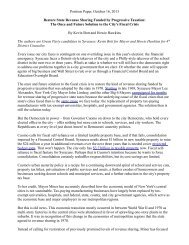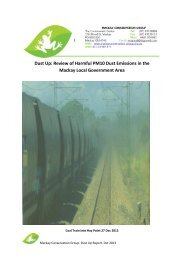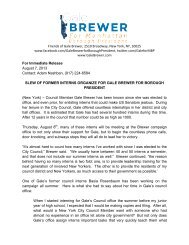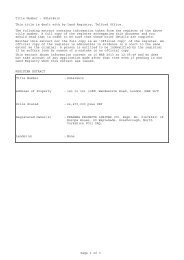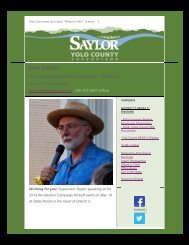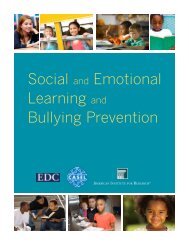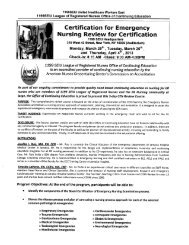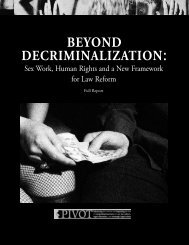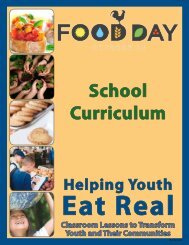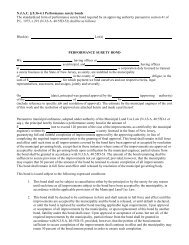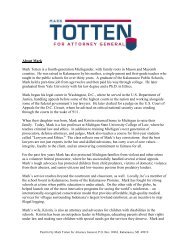You also want an ePaper? Increase the reach of your titles
YUMPU automatically turns print PDFs into web optimized ePapers that Google loves.
Lesson 1: Eat Real<br />
— Getting Started —<br />
Overview<br />
In this lesson, students learn why eating real, that is<br />
eating whole foods from plants and animals — fruits,<br />
vegetables, whole grains, legumes, lean meats, poultry,<br />
fish and low fat diary products — is so important.<br />
They are packed with the nutrients our bodies need.<br />
They keep us going today, and help us stay healthy<br />
long into the future. <strong>Food</strong> tastings with fresh, locally<br />
produced fruits and vegetables are recommended for<br />
students to experience wholesome eating. Students<br />
then contrast whole foods with overly processed foods,<br />
such as sweetened beverages, chips, and candy. These<br />
foods lack essential nutrients and are loaded with fat,<br />
salt, and sugar. The lesson ends with students making<br />
an Eat Real Action Plan to replace overly processed<br />
foods with whole foods. Possible action plans are:<br />
replace a bag of chips with a piece of fruit; replace<br />
soda with an ice cold glass of tap water adorned with<br />
lemon, orange, or cucumber slices; have a salad with<br />
lunch and skip the popsicle.<br />
Behavior Change Objective<br />
As a result of this lesson, students will eat more whole<br />
foods from plants and animals and fewer overly<br />
processed foods.<br />
Learning Objectives<br />
Students will be able to:<br />
• explain what it means to “Eat Real;”<br />
• describe the health and ecological benefits<br />
of eating more whole foods and fewer overly<br />
processed foods;<br />
• list foods that are whole, foods that are minimally<br />
processed (changed a little), and foods that are<br />
overly processed (changed a lot);<br />
• create a personal action plan to eat a whole food<br />
instead of a processed food.<br />
Background for Teachers<br />
The foods we enjoy should promote, not undermine,<br />
our good health. Several hundred thousand Americans<br />
die prematurely every year due to what we eat,<br />
with medical costs running well over $100 billion.<br />
A healthy diet, especially one that follows the goals<br />
of “Eat Real,” “Mostly Plants,” and “Not Too Much”<br />
as is promoted in these lessons, can lower blood<br />
pressure, cholesterol levels, blood sugar, and prevent<br />
everything from tooth decay and obesity to heart<br />
disease, stroke, diabetes, and cancer. By teaching<br />
these lessons, you are playing a role in helping your<br />
students reach their fullest potential now, as well as<br />
maintaining their health in the future.<br />
Although many nutrition lessons consist of students<br />
learning about food groups and how to sort foods<br />
into these group, this typically does not translate<br />
into healthful eating behaviors. The <strong>Food</strong> <strong>Day</strong><br />
curriculum takes the stance that to effectively change<br />
what students eat, we need to focus on specific, clear<br />
behaviors. During the activities in the <strong>Food</strong> <strong>Day</strong><br />
lessons, students will become motivated to follow the<br />
<strong>Food</strong> <strong>Day</strong> Eating Goals and learn practical skills for<br />
making positive changes to their diet.<br />
This lesson is about eating real. That means eating<br />
more whole foods — foods that come right from<br />
plants and animals. Students see beautiful, enticing<br />
photographs of real foods so they know what eating<br />
real means and feel good about eating real. They then<br />
see how foods can be changed or processed into other<br />
things. Sometimes some processing is useful, such as<br />
grinding wheat berries to make whole-wheat flour<br />
— but far too many of the foods available around us<br />
are overly processed and are dramatically changed to<br />
something unrecognizable from their plant and/or<br />
animal origins. Over-processing removes nutrients<br />
and adds excessive sugar, fat, and salt. In all the <strong>Food</strong><br />
<strong>Day</strong> lessons, students take what they learn out of the<br />
classroom door by creating action plans. Actively<br />
making changes now can help them build positive<br />
habits for the future. In this lesson, the action plan<br />
is to eat a whole food instead of an overly processed<br />
food, getting them on the path to “Eat Real.”<br />
<strong>Food</strong> <strong>Day</strong> Lessons | 9



